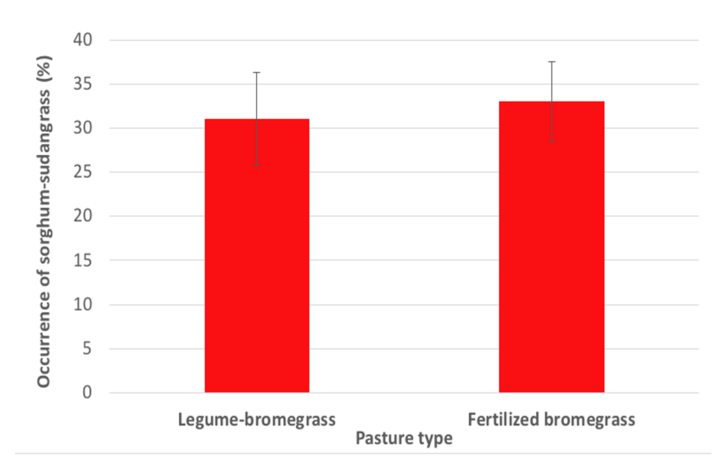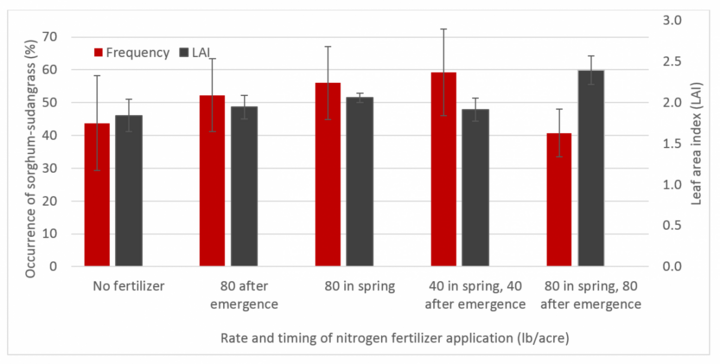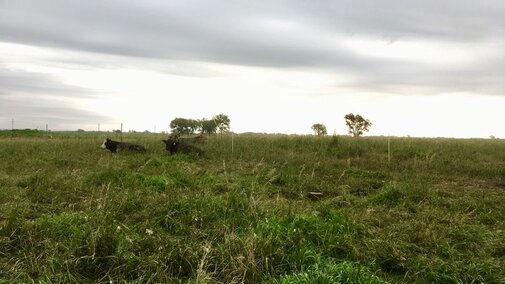Why Interseed Sorghum-Sudangrass?
A growing demand for beef cattle production in Nebraska is putting more pressure on pastureland. Much of pastureland in Nebraska is dominated by smooth bromegrass (Bromus inermis Leyss). The perennial grass is highly productive in the spring and fall, but hot temperatures reduce its growth through the summer months, creating a gap in forage production. One strategy producers in eastern Nebraska might use to increase productivity of smooth bromegrass pastures and fill the summer forage gap is to interseed annual forage crops such as sorghum-sudangrass.
Advantages and Disadvantages of Sorghum-Sudangrass
Sorghum-sudangrass has several benefits as a summer forage crop. It has the potential to produce large amounts of biomass as it can rapidly reach 6-12 feet tall. Because of its waxy leaves, it is less susceptible to water loss and does well in drought-stress conditions. With multiple tillers and a deep root system, sorghum-sudangrass can help to break up compacted ground and aerate soil. One concern may be the prussic acid produced by the grass. In large doses this acid can be harmful to grazing cattle, but is most potent when plants are young or stressed. To avoid prussic acid poisoning, producers should allow sorghum-sudangrass to grow to 18-24 inches in height before grazing and avoid grazing right after hail or frost damage.
Interseeding Research
In 2018 two experiments were initiated at the University of Nebraska-Lincoln Eastern Nebraska Research and Extension Center near Mead to evaluate how nitrogen management affects establishment of sorghum-sudangrass in pastures. One experiment was conducted in grazed pastures while the other was conducted in plots laid out and arranged in an ungrazed pasture.
Pasture Experiment
The pasture-scale experiment compared sorghum-sudangrass establishment in three replicated pastures consisting of nitrogen-fertilized smooth bromegrass relative to establishment in three replicated unfertilized pastures consisting of smooth bromegrass and various legume species (alfalfa, red clover, and birdsfoot trefoil). Each pasture was divided into six paddocks and rotationally stocked with beef cattle yearlings from May to September. Before grazing began, two of the paddocks were designated experimental strips for interseeding of sorghum-sudangrass. On May 4 cattle were introduced to the experimental strips and allowed to graze the pasture to 3-4 inches (Figure 1).
After a second grazing rotation through the strips in June, each strip was interseeded with sorghum-sudangrass, on June 7 and 16, respectively. The seeder used was a 5-foot wide Great Plains no-till drill with a 6-inch row spacing and a target pure live seeding rate of 37 lb/ac. The fertilized experimental strips received an application of 80 lbs N/ac on June 22 when sorghum-sudangrass started emerging. On July 11 we assessed establishment in each of the two vegetation types by visually assessing the frequency of occurrence of sorghum sudangrass at six random locations in each pasture.
Did the Presence of Legumes Make a Difference?

The data showed that frequency of occurrence of sorghum-sudangrass did not differ between pasture types (Figure 2). This means that the presence of legumes in smooth bromegrass pastures does not affect the establishment of sorghum-sudangrass any differently than nitrogen fertilization of pastures.
Plot Experiment
The second study evaluated sorghum-sudangrass establishment in smooth bromegrass pastures in response to five treatments that varied the rate and time of nitrogen fertilizer application. The treatments included broadcast application of granular urea at 0, 80, or 160 lb N/acre with application times in either early spring, after emergence of sorghum-sudangrass, or at both times. Growth of smooth bromegrass was allowed to accumulate throughout spring until it was mowed to a 3-inch stubble height and removed from the plots on May 31.
Samples of the removed forage were saved for later determination of how the rate and time of nitrogen fertilization application affected forage mass of smooth bromegrass during spring. In the meantime, however, on June 7, sorghum-sudangrass was interseeded into the plots using the same drill as in the pasture experiment. On June 27, shortly after the emergence of sorghum-sudangrass, we assessed competition from smooth bromegrass by measuring the amount of light penetration in the canopy and canopy leaf area index (LAI). On July 9 the frequency of occurrence of sorghum-sudangrass seedlings in the plots was measured.
Did Rate and Time of Nitrogen Fertilizer Application Have an Effect?
The frequency of occurrence results showed that the rate and time of nitrogen fertilizer application did not significantly affect establishment of sorghum-sudangrass. Plots that received 80 lb N/acre in spring and after emergence, though, tended to have both reduced occurrence of sorghum sudangrass and greater LAI (Figure 3; far-right bars). This means that high rates of nitrogen fertilization would likely reduce production of sorghum-sudangrass and limit the effectiveness of this strategy toward filling the summer slump in smooth bromegrass pastures.

What Does it all Mean?
Smooth bromegrass pastures can provide an excellent source of forage during spring, but during summer, less soil moisture along with greater temperatures reduce its growth. One strategy to enhance production of smooth bromegrass pastures during summer would be to interseed a summer annual grass such as sorghum-sudangrass. In previous plot research, we have found promising results of doing so. However, a challenge that producers might face when interseeding sorghum-sudangrass in grazed pastures is getting successful stand establishment. We have wondered what role nitrogen management might have in influencing these results, and that led us to initiate these experiments.
Although these results represent only one year of data, they suggest that nitrogen management has a limited effect on establishment of sorghum-sudangrass. Rather, other factors such as getting successful seed-to-soil contact may have more importance. Whether seeding into a mixed legume-smooth bromegrass pasture or a monoculture of smooth bromegrass, sorghum-sudangrass will establish the same in both pasture types. If focus is placed on only establishing a stand of sorghum-sudangrass, it doesn’t matter when you apply fertilizer or how much you apply.
Before interseeding sorghum-sudangrass could be recommended as a good strategy for filling the summer forage slump, more research needs to be done on the amount of forage produced with the presence of legumes and how fertilizer rate and application timing affect the amount of yearly biomass produced.
About the Author
Brooke George is one of nine undergraduate students who completed an Integrated Agronomic Systems Fellowship at the University of Nebraska-Lincoln in summer 2018. She is pursuing her bachelor's degree at Brigham Young University Idaho.
Support
This project was made possible by the USDA NIFA Agriculture and Food Research Initiative: Education and Literacy Initiative–Undergraduate Experiential Learning Fellowship Program and by the University of Nebraska-Lincoln Department of Agronomy.

